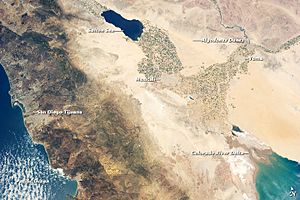Salton Trough facts for kids
The Salton Trough is a large, low-lying area of land. It's like a big valley that has sunk down. You can find it in southeastern California, United States, stretching into Baja California, Mexico. This trough starts near the San Gorgonio Pass and goes about 115 miles (185 km) southeast to the Gulf of California.
Inside the Salton Trough, you'll find important places like the Coachella Valley, the Salton Sea, and the Imperial Valley in the U.S. In Mexico, it includes parts of the Mexicali Valley and the Colorado River Delta.
This huge valley formed because the Earth's crust is stretching and sinking. This happens due to the powerful movements of the San Andreas Fault and the East Pacific Rise. These two major geological features meet near the southern end of the Salton Sea. This meeting point is called the Brawley Seismic Zone. It's a very active area where the Earth's crust is pulling apart.
The Salton Trough is also known as a "sedimentary basin." This means it has filled up with lots of sand, mud, and rocks over time. These sediments come from the mountains around the trough and from the Colorado River. In some spots, these layers of sediment are incredibly deep, more than 20,000 feet (6,100 meters)! Long ago, the Colorado River used to fill a huge lake here called Lake Cahuilla. But then the river changed its path, and the lake disappeared.
What makes the Salton Trough special?
- Lowest Point: The lowest part of the Salton Trough is called the Salton Sink. It sits about 236 feet (72 meters) below sea level. This makes it the second-lowest point in North America, after Death Valley.
- Lowest Lake: The Salton Sea fills the very lowest part of the Salton Sink. At about 210 feet (64 meters) below sea level, it is the lowest lake in North America.
- Earthquake Swarms: The Salton Trough often experiences groups of earthquakes, called earthquake swarms. These are many small quakes that happen close together.
- Volcanic Activity: You can find the Salton Buttes within the Salton Sea. These are small, dome-shaped hills made from hardened lava. They were active volcanoes about 10,300 years ago.
- Geographic Region: In geography, the Salton Trough is considered a unique part of the larger Basin and Range province in North America.


